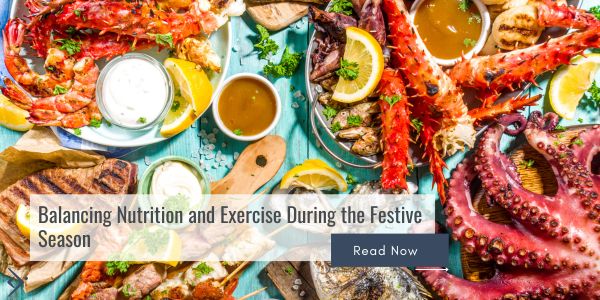Christmas is all about spending time with your loved ones. But between the after-work drinks, holiday parties and Christmas feasts, it can be tricky to maintain healthy, consistent nutrition and exercise habits.
We’ve put together this easy-to-follow guide that simplifies nutrition and exercise at Christmas so you can walk the fine line between a good time and too much of a good thing.
Navigating Nutrition During the Holidays and Busy Periods
Striking the right balance of nutrition and exercise during Christmas can be challenging. It’s a time for celebration, and that includes enjoying the delicious food that comes with it. Don’t beat yourself up over a little indulgence. One day of festive feasting won’t derail your overall health and well-being goals.
Remember that body weight and physical appearance are never more important than health and happiness. If treating yourself at Christmas is what fills your cup, then go ahead and indulge. If being mindful of nutrition and exercise is important to you, then that’s okay too. But keep in mind, there’s no such thing as a perfect diet, so go easy on yourself.
Common Nutrition Mistakes to Avoid At Christmas
Health and happiness look different for everyone, but there are a few common mistakes that a lot of people make at Christmas. Sometimes, being aware of these mistakes is enough to avoid them. But if you prefer to have a game plan heading into the festive season, we’ve added in some handy tips to make navigating nutrition at Christmas easier.
Over-restricting
Restricting yourself during the festive season can trigger feelings of deprivation, stress, and anxiety. The holiday spirit is all about indulgence, and denying yourself certain foods might make you feel like you’re missing out on the things that make this once-a-year occasion special. Plus, the effort required to constantly dodge what you might label as “sometimes foods” can become tiring, sapping the joy from the season.
TIP: Mindful indulgence is better for you and your mental health. Instead of setting rigid rules, allow yourself to enjoy festive treats in moderation. Pick a few of your favourites, alongside more nutrient-dense foods, and savour them without guilt.
Grazing
Charcuterie and cheese boards are in right now. Even though there’s not a lot of nutritional benefit to them, it’s hard to resist piles of salty, savoury cheeses, meats and crackers. But it’s even harder to keep track of what you’re eating and how much you’re eating. When you nibble away for hours, you can even miss your hunger cues, eating long after your stomach is full.
TIP: It’s easier to keep track of what you’re eating when you opt for full meals over snacking or grazing. The structured nature of meals allows for a more conscious awareness of what you’re consuming, making it easier to ensure you’re getting a well-rounded mix of nutrients. You’re also better able to tune in to your body’s hunger cues and stop eating when you’re comfortably full.
TIP: If you can’t avoid grazing, make sure you’re nibbling on veggie sticks and fruit pieces at least as much as you’re reaching for cheeses and meats.
TIP: Use a side plate to portion out your selection, again allowing yourself to have the enjoyment of cheese boards whilst mindfully eating.
Fearing carbs and fats
It’s easy to be overwhelmed by the sheer volume of food we’re presented with over Christmas. Sometimes it’s simpler to stick to the salads than to branch out and try something new. But not every festive food is ‘bad’ for us.
The good fats in foods like avocados, nuts, and olive oil are crucial for a balanced diet. These healthy fats, called monounsaturated fatty acids, not only keep your heart in good shape but also help you feel satisfied after eating.
The energy-packed carbohydrates found in foods like grains, fruits, and veggies are also a key part of a balanced diet. These carbs provide fuel for your body, helping you power through your day and stay fuller for longer.
TIP: Balance your plate by filling half with a variety of veggies and salad. Fill a quarter of your plate with lean proteins like turkey, prawns or even ham. Top the last quarter off with complex carbohydrates like roasted root veg. You can also add a serving of healthy fats, like a quarter of avocado, if your meal doesn’t already include oil.
TIP: If your idea of celebrating involves eating an extra serving of your favourite side, or filling up a bowl with desserts, that’s perfectly okay — it’s just one day! Just remember to listen to your body and stop when you feel full.
Practical Tips for Balancing Nutrition and Exercise During the Holidays
If you want to stay mindful, but not strict, about your nutrition and exercise this Christmas, here are a few extra tips:
- Take the salad: A lot of the sides featured in a typical Aussie Christmas spread are nutritionally dense. By taking a salad, you can be confident that there’ll be at least one body-nourishing thing on your plate.
- Eat slowly: It’s easy to get excited and overeat. Our brains take a little while to catch up with our stomachs, so put your cutlery down, participate in conversation, these things will help slow your meal down and you’ll be better able to know when you’re full and when to stop eating.
- Go zero-alc: Swapping your drinks for zero-alcohol alternatives can help you let loose without the Boxing Day hangover.
- Get active: Not many people have time to go to the gym at Christmas. Instead, incorporate physical activity into your day by jumping in the pool with your family, running around with the kids or taking everyone on an afternoon walk. An afternoon walk is a great way to energise those family members that tend to fall asleep in the afternoon on Christmas day.
It’s all about health and happiness
Feeling ready to tackle nutrition and exercise with a balanced, guilt-free outlook this Christmas? Don’t forget to download the Health & Happiness (NOT Weight) guide for help with keeping the mindset up.











